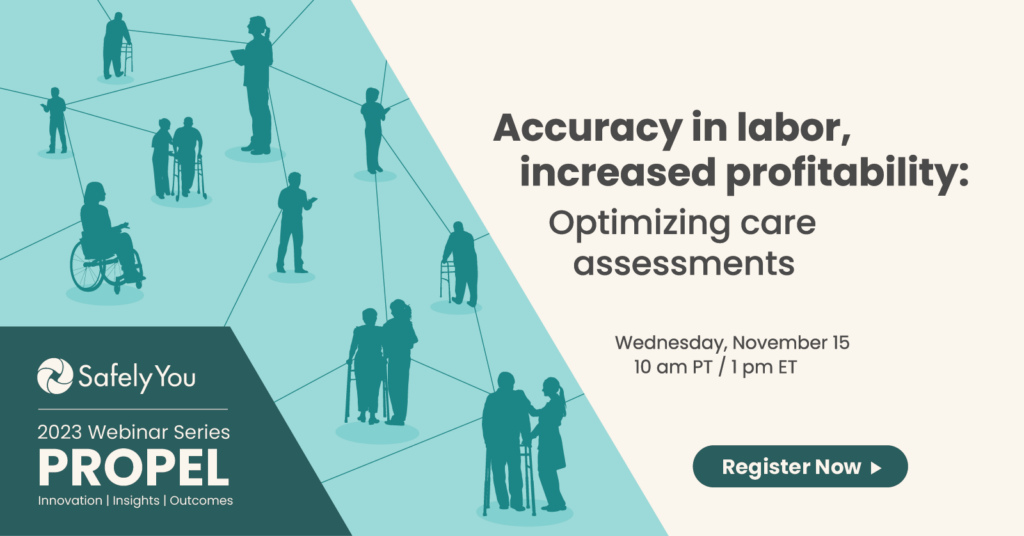As we age, physical changes and health conditions make falls more likely. In fact, falls are a leading cause of injury among older adults. And adults living with dementia fall at least four times per year — twice as often as adults without dementia. But fall prevention interventions, like those outlined below, can reduce the risk of fall events and help keep memory care residents safe.
Designing a safe living space for fall prevention
Before a resident moves into a community, it’s important to develop a bedroom checklist with the family and explain risks regarding specific furniture.
Items to consider when designing a space for fall prevention
- Bed size (will dictate position in the room)
- Dresser (limit number of drawers)
- Bedside table <(address corners)
- Lamp (easy to turn on/off)
- TV and console table (viewing point)
- Chair with arms (appropriate for mobility)
- Accessible storage/shelving
- Mobility status influences design: Remember to factor in the range of mobility when designing a bedroom.
- No mobility aid: Reduce risk by making sure items are within reach of standing or sitting.
- Two- or four-wheeled walkers: Room should have more space for the pathway to exit, which means no bulky furniture and positioning the bed against a wall.
- Wheelchair: Ensure there is additional space for safe transfers from bed and chairs with multiple care staff in the room.
Fall prevention intervention exercises
Exercises that focus on balance and strength training are fall prevention interventions that can reduce the risk of falling.
While they may have difficulty learning new activities, those living with dementia can benefit from going through the motions of balance and strength training.
Activities such as squatting, standing up from a chair, and walking may be difficult or cause many to feel unsteady, which increases their risk of falling. So, people living with dementia must practice balance and strength training with a professional to ensure their safety. The following links provide an easy guide for sit and stand, balance and seated chair exercises which can be adapted for those living with dementia:
- Fall Prevention Exercises: Simple Exercises Can Prevent Falls for People Living with Dementia
- Fall Prevention: Balance and Strength Exercises for Older Adults
- Seated Chair Exercise
Fall preventions interventions for falling out of bed
It’s not uncommon for a resident to fall or roll out of bed. However, there are measures you can put in place to help prevent those fall events from happening. If you have a resident falling or rolling out of bed, consider implementing ideas from the following fall interventions list.
Fall prevention interventions for rolling or falling out of bed
Modify wheelchair: Add anti roll-back systems to wheelchairs.
-
- Transfer aids: Provide transfer poles, bed canes or halos to assist residents with transfers. A hospital bed with a half rail should be considered a safety measure as well.
- Establish transfer technique policy: It is crucial to have 100% staff compliance on your community’s policy for proper transfer techniques, such as using gait belts when appropriate and transfer equipment when applicable (i.e. hoyer, sit-to-stand device, etc.).
- Training: There can never be enough training, so train and retrain the care staff on transfer techniques on a regular basis.
Learn more about dementia and falling out of bed.
Fall prevention interventions to reduce transfer risks
Falls often happen when a resident tries to move from a wheelchair to a chair or bed or from a sitting to a standing position without help. When residents are assisted with transfers, they only fall 1% of the time. The following are great solutions for preventing transfer falls.
Fall prevention interventions to reduce falls when a resident transfers:
- Modify wheelchair: Add anti roll-back systems to wheelchairs.
- Transfer aids: Provide transfer poles, bed canes or halos to assist residents with transfers. A hospital bed with a half rail should be considered as safety a measure as well.
- Establish transfer technique policy: It is crucial to have 100% staff compliance on your community’s policy for proper transfer techniques, such as using gait belts when appropriate and transfer equipment when applicable (i.e. hoyer, sit-to-stand device, etc.).
- Training: There can never be enough training, so train and retrain the care staff on transfer techniques on a regular basis.
- Physical/Occupational Therapy: Leverage therapy referrals regularly to ensure residents have the appropriate mobility aids and transfer assistance for their changing condition.
These interventions can help prevent falls in your community, increasing safety and improving resident well-being. Make them part of your comprehensive fall management program. SafelyYou can help elevate fall management in your communities, too. We combine trusted technology with expert insights to not only detect falls and help prevent future falls, but to create safer environments where residents stay longer.
Learn more about how to reduce transfer risks and prevent falls in memory care.
For more details on preventing falls, please download the whitepaper, Best Practices for Fall Prevention.





